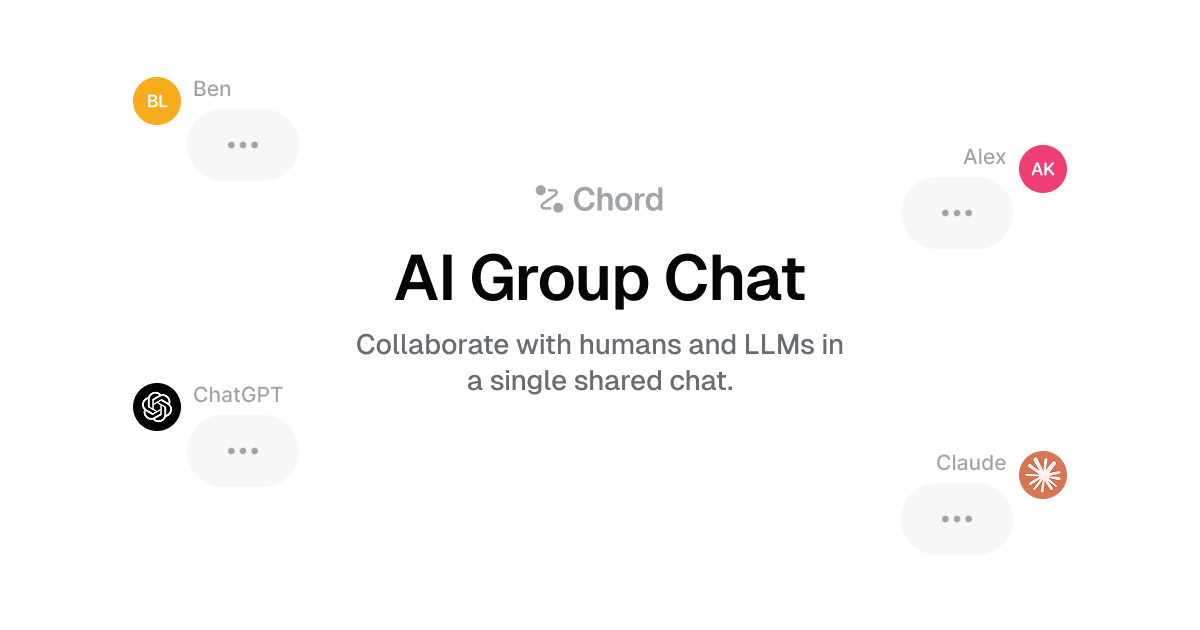Table of Contents
Overview
Chord represents an innovative approach to team-AI collaboration in the rapidly evolving landscape of artificial intelligence tools. This platform creates unified chat environments where team members can simultaneously interact with multiple leading AI models, transforming how organizations approach collaborative AI-assisted work. Rather than managing separate AI conversations or sharing static links, Chord provides a persistent, multi-participant workspace designed for seamless human-AI co-creation.
Key Features
Chord delivers a comprehensive suite of collaboration-focused capabilities designed to streamline team-AI interactions:
- Multiplayer AI Chat Rooms: Dedicated collaborative spaces supporting simultaneous participation from multiple users and AI models, enabling dynamic group discussions with AI assistance.
- Shared Context and History: Unified conversation threads maintain complete context across all participants, ensuring continuity and eliminating information silos typically found in individual AI interactions.
- Multi-LLM Integration: Access to diverse AI models including OpenAI’s GPT series, Anthropic’s Claude, Google’s Gemini, and local open-source models within single conversations, allowing teams to leverage different AI strengths for varied tasks.
- Real-time Team Collaboration: Immediate interaction capabilities facilitate instant feedback loops and iterative development processes between human team members and AI assistants.
- Streamlined Invitation System: Simple team member onboarding through direct invitations, reducing barriers to collaborative AI adoption.
- Persistent Conversations: Chat continuity across sessions enables ongoing projects and long-term collaborative relationships with AI models.
- Context Import Functionality: Ability to import existing LLM conversations as contextual foundation for new collaborative sessions.
- Comprehensive Media Support: Document integration capabilities supporting various file formats including CSV, PNG, JPG, JSON, and TXT files for enhanced contextual AI interactions.
How It Works
Chord operates through an intuitive team-centered approach to AI collaboration. Users establish dedicated chat rooms serving as collaborative headquarters for both human team members and selected AI models. The platform maintains comprehensive conversation history and context across all sessions, ensuring seamless information flow and collaborative continuity. This persistent architecture allows ongoing dialogues and co-working sessions to resume exactly where they concluded, supporting extended project development cycles.
Use Cases
The platform’s versatile design supports numerous professional applications where human-AI collaboration creates value:
- Strategic Brainstorming: Generate and refine ideas collaboratively using AI assistance while maintaining team input and creative direction.
- Software Development: Collaborative coding sessions where AI models assist with code generation, debugging, and optimization alongside development teams.
- Research and Analysis: Leverage AI processing capabilities for information synthesis and analysis, followed by team discussion and insight development within shared contexts.
- Content Creation and Marketing: Develop compelling content with AI assistance, enabling real-time team review and refinement before implementation.
- Knowledge Management: Create centralized repositories combining AI-generated insights with team expertise for organizational learning and reference.
- Customer Support Enhancement: Utilize AI for initial response drafting and support, with human agents providing complex query resolution within unified conversation contexts.
Advantages and Considerations
Strengths
- Unified Communication Environment: Eliminates context-switching between AI platforms and team communication tools, creating streamlined workflows.
- Persistent Shared Context: Maintains comprehensive conversation history accessible to all participants, reducing redundancy and improving decision-making continuity.
- Multi-Model Access: Provides flexibility to leverage different AI capabilities within single conversations, optimizing task-specific performance.
- Cost-Effective Access: Currently available at no cost, making it accessible for teams exploring AI collaboration without immediate financial commitment.
Areas for Development
- Enterprise Integration Limitations: Current integration ecosystem remains limited compared to established enterprise collaboration platforms, potentially requiring additional workflow adjustments.
- Privacy and Security Considerations: Teams handling sensitive information should carefully evaluate data handling practices when sharing content with multiple AI models in collaborative settings.
- Model Management Complexity: While multi-LLM support provides flexibility, teams may need to develop protocols for optimal model selection and task assignment.
Competitive Landscape Analysis
When evaluating Chord against established alternatives, its unique multi-participant, multi-model approach creates distinct positioning:
- ChatGPT Teams: While offering robust individual AI capabilities and dedicated team workspaces with custom GPT sharing, ChatGPT Teams primarily focuses on individual AI interactions within team contexts rather than true multiplayer AI chat rooms. ChatGPT Teams provides enterprise-grade security, admin controls, and extensive feature sets but lacks Chord’s multi-model integration and simultaneous multi-user AI interaction design.
- Slack AI Integration: Slack excels in enterprise integration and existing workflow incorporation, with AI capabilities embedded within established communication channels. However, its emphasis remains on enhancing existing team communication rather than creating dedicated AI collaboration environments with persistent multi-model support.
- Anthropic Claude Projects and Workspaces: Claude offers sophisticated reasoning capabilities through its Projects feature, which allows teams to create shared workspaces with document uploads and contextual AI interactions. While Claude Projects provides excellent team collaboration within the Claude ecosystem, it lacks the multi-model support and explicit multiplayer chat room design central to Chord’s value proposition.
Pricing and Accessibility
Chord currently operates under a freemium model, providing core collaborative AI features without cost. This approach enables teams to explore AI collaboration benefits without immediate financial investment, though future pricing structures may introduce tiered offerings as the platform matures and adds enterprise-focused capabilities.
Conclusion
Chord addresses a specific need in the evolving AI collaboration landscape by creating dedicated environments for human-AI team interaction. Its focus on multi-participant, multi-model conversations represents a novel approach to collaborative AI utilization. While the platform shows promise for teams seeking integrated AI collaboration solutions, organizations should consider their specific enterprise integration requirements, security needs, and long-term collaboration strategies when evaluating Chord against more established alternatives. The platform’s current free availability makes it an attractive option for teams exploring collaborative AI workflows, particularly those requiring multi-model flexibility and persistent team-AI interaction contexts.
Important Note: As Chord continues developing, teams should monitor feature evolution, pricing changes, and enterprise capability expansion to ensure alignment with organizational collaboration strategies and security requirements.
